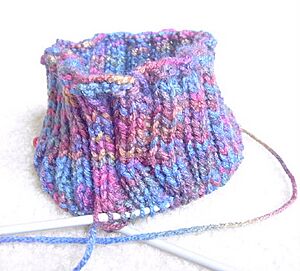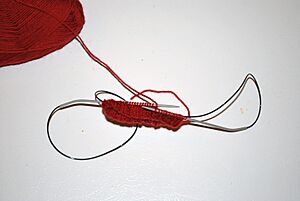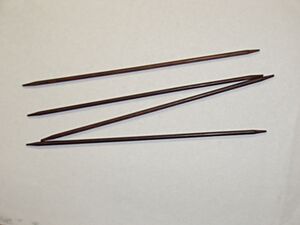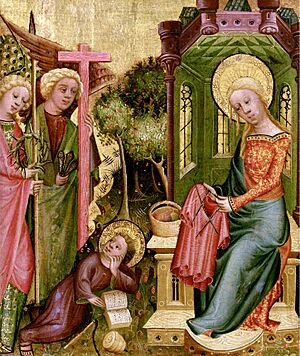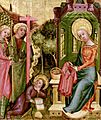Circular knitting facts for kids
Circular knitting is a special way of knitting that creates a seamless tube of fabric. Imagine knitting a long sock or a hat without any seams! This method is also called knitting in the round. It's super useful for making things like socks, mittens, hats, and sweaters, because you don't have to sew pieces together when you're done.
Contents
What is Circular Knitting?
When you knit in the round, you are always knitting on the "right side" of your fabric. This means you don't have to turn your work around at the end of each row. Instead, you keep knitting in a continuous circle. This creates a smooth, unbroken fabric that looks great and feels comfortable. It's like building a tube, stitch by stitch.
Why Knit in the Round?
Knitting in the round has some cool benefits:
- No Seams: The biggest advantage is that you don't have to sew seams later. This saves time and makes your finished project look very neat.
- Comfort: Seams can sometimes feel bulky or scratchy. Seamless items are often more comfortable to wear, especially for things like socks or hats.
- Faster Finishing: Since there's no seaming, your project is ready to use much quicker once you've finished the last stitch.
Tools for Circular Knitting
To knit in the round, you need special knitting needles. There are a few different types you can use:
Circular Needles
A circular needle is made of two short knitting needles connected by a flexible cable. They come in different lengths, from very short (for socks) to very long (for blankets or large sweaters). You can also find:
- Fixed Circular Needles: The cable is permanently attached to the needles.
- Interchangeable Circular Needles: These have tips that you can screw onto different lengths of cables. This means you only need one set of needle tips and can change the cable length for different projects.
Double-Pointed Needles (DPNs)
Double-pointed needles (often called DPNs) are short, straight needles that have points on both ends. You usually use a set of four or five of them. You arrange your stitches over three or four of the needles, and then you use the fifth needle to knit the stitches. DPNs are great for small projects like socks, mittens, or the tops of hats.
Magic Loop Method
The Magic Loop is a clever technique that lets you knit small circular projects using a single long circular needle. Instead of using DPNs, you pull a loop of the cable out between your stitches. This makes it possible to knit tiny tubes, like the fingers of gloves or the toes of socks, on a much longer needle.
What Can You Make?
Lots of everyday items are perfect for circular knitting:
- Hats: Most hats are knitted in the round, starting from the brim or the top.
- Socks: Socks are almost always knitted in the round to create a seamless, comfortable fit.
- Sweaters: Many sweaters are knitted from the top down or bottom up in one piece, avoiding side seams.
- Mittens and Gloves: The main part of mittens and gloves, and even the fingers, can be knitted in the round.
- Cowls and Scarves: You can make continuous loop scarves (cowls) without any seams.
History of Circular Knitting
Knitting has been around for a very long time. The earliest known examples of circular knitting come from the 15th century.
One famous example is a painting from the 15th century called "The Madonna of Humility" by Master Bertram. It shows Mary knitting a seamless garment, which is believed to be one of the first artistic depictions of circular knitting. This shows that knitters have been using this clever method for hundreds of years to create beautiful and practical items.
Images for kids
See also
 In Spanish: Tejido de punto circular para niños
In Spanish: Tejido de punto circular para niños


